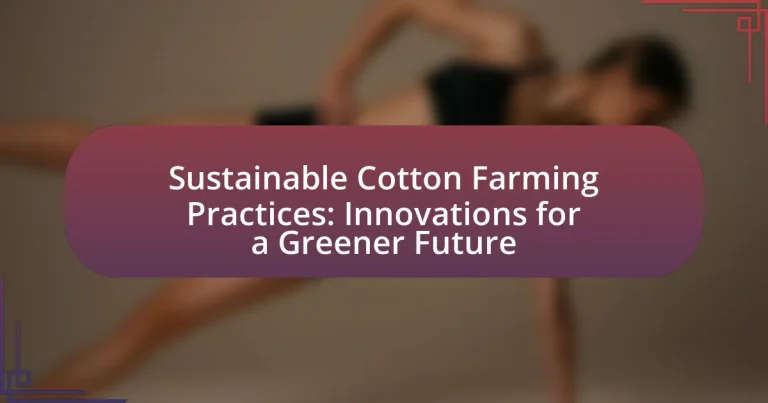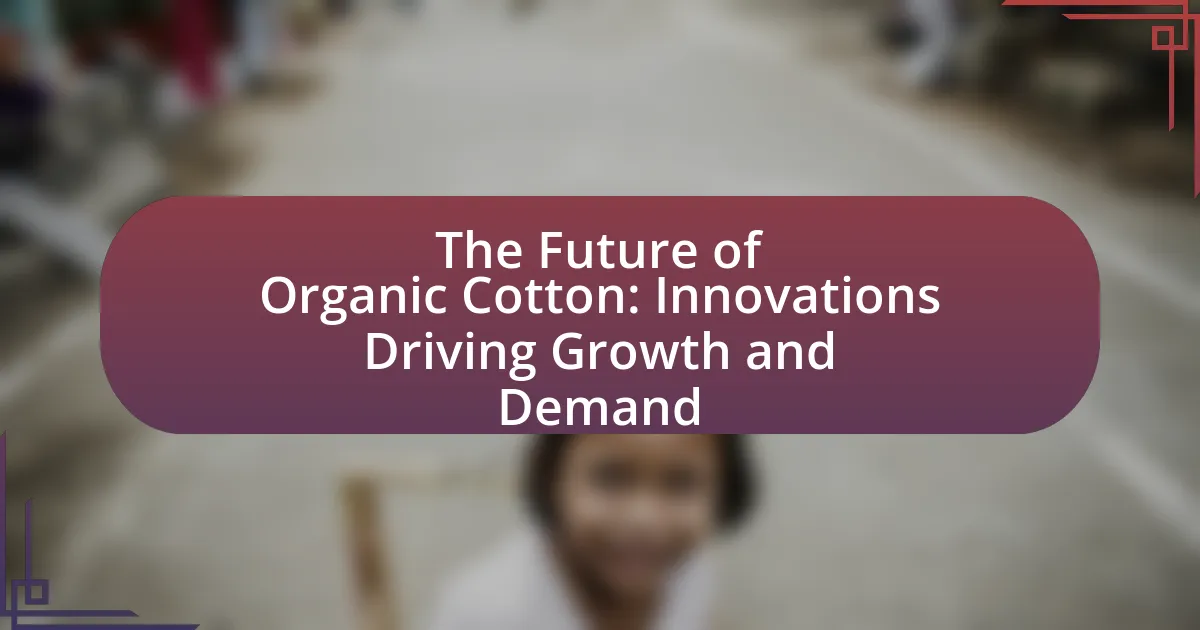Sustainable cotton farming practices focus on minimizing environmental impact while enhancing social and economic benefits. Key methods include crop rotation, integrated pest management, and organic farming techniques, which collectively reduce water usage, chemical inputs, and promote soil health. The article explores the importance of sustainability in cotton farming, the environmental impacts of conventional practices, and how innovations such as precision agriculture and biotechnology are transforming the industry. Additionally, it highlights the economic and social benefits for farmers, including improved livelihoods and community health, while addressing the challenges faced in adopting these sustainable practices.
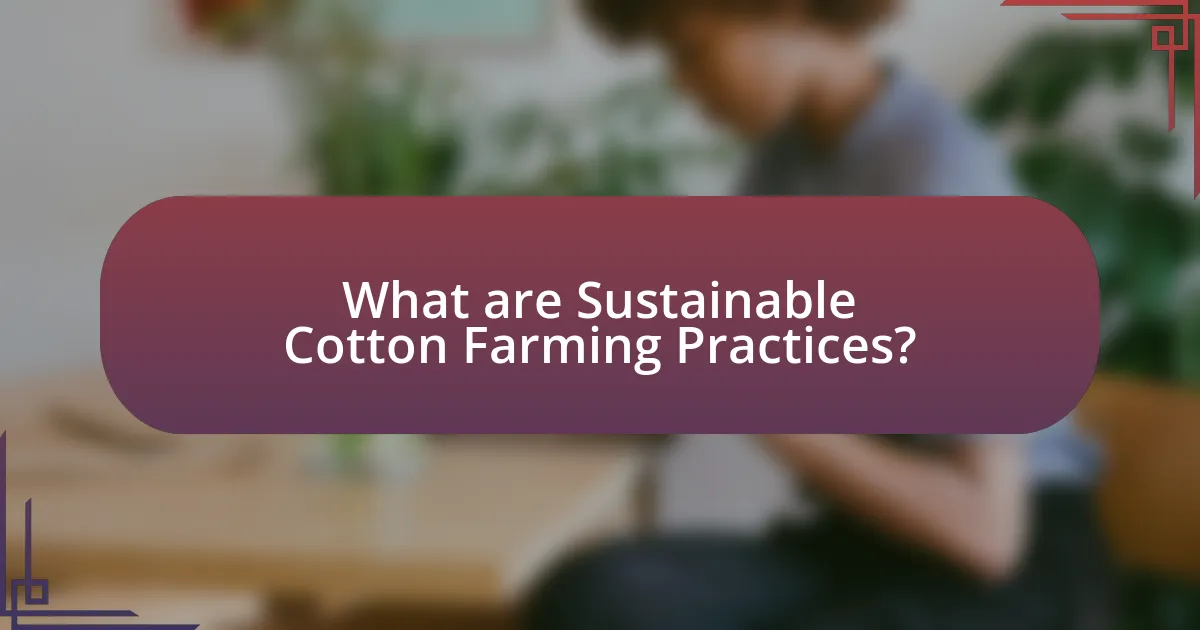
What are Sustainable Cotton Farming Practices?
Sustainable cotton farming practices are agricultural methods that aim to minimize environmental impact while promoting social and economic benefits. These practices include crop rotation, which enhances soil health and reduces pest populations; integrated pest management (IPM), which utilizes natural predators and biological controls to manage pests; and organic farming techniques that avoid synthetic fertilizers and pesticides. According to the Textile Exchange’s 2021 report, sustainable practices can reduce water usage by up to 90% compared to conventional methods, demonstrating their effectiveness in resource conservation. Additionally, sustainable cotton farming often involves fair labor practices, ensuring that workers receive fair wages and safe working conditions, which contributes to the overall sustainability of the industry.
Why is sustainability important in cotton farming?
Sustainability is important in cotton farming because it reduces environmental impact and promotes resource conservation. Sustainable practices, such as organic farming and integrated pest management, minimize chemical use, which protects biodiversity and soil health. According to the World Wildlife Fund, conventional cotton farming uses approximately 16% of the world’s insecticides, leading to significant ecological harm. By adopting sustainable methods, cotton farmers can enhance soil fertility, reduce water consumption, and lower greenhouse gas emissions, contributing to a healthier ecosystem and ensuring long-term viability of cotton production.
What environmental impacts does conventional cotton farming have?
Conventional cotton farming has significant environmental impacts, primarily due to its high water consumption, pesticide use, and soil degradation. The cultivation of cotton requires approximately 7,000 liters of water to produce just one kilogram of cotton, leading to water scarcity in many regions. Additionally, conventional cotton farming often relies on synthetic pesticides and fertilizers, which can contaminate soil and water sources, harming local ecosystems and biodiversity. Studies indicate that cotton farming contributes to soil erosion and nutrient depletion, reducing land productivity over time. These practices not only threaten the environment but also affect the livelihoods of communities dependent on healthy ecosystems.
How does sustainable cotton farming mitigate these impacts?
Sustainable cotton farming mitigates environmental impacts by employing practices that reduce water usage, minimize chemical inputs, and enhance soil health. For instance, techniques such as crop rotation and organic pest management decrease reliance on synthetic fertilizers and pesticides, leading to less soil and water contamination. Additionally, sustainable practices like rainwater harvesting and drip irrigation significantly lower water consumption, addressing the critical issue of water scarcity in cotton production. Research indicates that sustainable cotton farming can reduce water usage by up to 50% compared to conventional methods, demonstrating its effectiveness in conserving resources while maintaining productivity.
What are the key principles of sustainable cotton farming?
The key principles of sustainable cotton farming include efficient water management, integrated pest management, soil health maintenance, and promoting biodiversity. Efficient water management involves using techniques such as drip irrigation to minimize water waste, which is crucial given that cotton is a water-intensive crop. Integrated pest management focuses on reducing chemical pesticide use by employing natural predators and crop rotation, thereby protecting both the environment and human health. Soil health maintenance is achieved through practices like cover cropping and reduced tillage, which enhance soil fertility and structure. Promoting biodiversity involves planting diverse crops and maintaining natural habitats, which supports ecosystem resilience. These principles are supported by research indicating that sustainable practices can lead to higher yields and lower environmental impact compared to conventional methods.
How do crop rotation and diversification contribute to sustainability?
Crop rotation and diversification significantly contribute to sustainability by enhancing soil health, reducing pest and disease pressure, and improving biodiversity. Crop rotation involves alternating different crops in a specific sequence, which helps maintain nutrient balance in the soil and reduces the reliance on chemical fertilizers. For instance, legumes can fix nitrogen in the soil, benefiting subsequent crops. Diversification, through planting various crops, creates a more resilient agricultural system that can better withstand environmental stresses and market fluctuations. Research indicates that diversified farming systems can increase yields by up to 20% compared to monocultures, demonstrating their effectiveness in promoting sustainable practices.
What role does soil health play in sustainable practices?
Soil health is crucial for sustainable practices as it directly influences crop productivity, ecosystem balance, and resource efficiency. Healthy soil enhances nutrient availability, improves water retention, and supports biodiversity, which are essential for sustainable cotton farming. Research indicates that practices such as cover cropping and reduced tillage can significantly improve soil organic matter and microbial activity, leading to better soil health. For instance, a study published in the journal “Agriculture, Ecosystems & Environment” found that improved soil health through sustainable practices can increase cotton yields by up to 30%, demonstrating the vital link between soil health and sustainable agricultural outcomes.
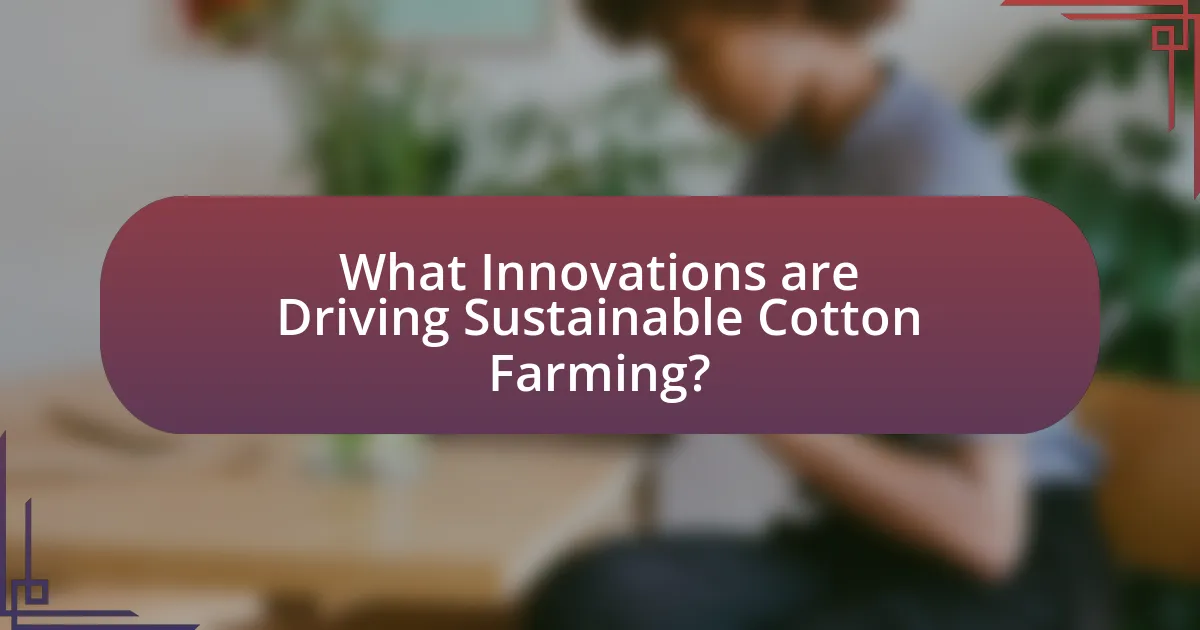
What Innovations are Driving Sustainable Cotton Farming?
Innovations driving sustainable cotton farming include precision agriculture, organic farming techniques, and biotechnology. Precision agriculture utilizes data analytics and technology to optimize resource use, reducing water and chemical inputs by up to 30%, as reported by the Food and Agriculture Organization. Organic farming techniques, which avoid synthetic pesticides and fertilizers, have shown to improve soil health and biodiversity, with studies indicating that organic cotton can yield comparable profits to conventional methods. Biotechnology, such as genetically modified cotton varieties, enhances pest resistance and reduces the need for chemical treatments, contributing to lower environmental impact. These innovations collectively promote sustainability in cotton farming by improving efficiency and reducing ecological footprints.
How is technology transforming sustainable cotton farming?
Technology is transforming sustainable cotton farming by enhancing efficiency, reducing resource consumption, and improving crop management. Precision agriculture technologies, such as GPS-guided equipment and drones, allow farmers to monitor crop health and soil conditions in real-time, leading to optimized water usage and reduced pesticide application. For instance, a study by the International Cotton Advisory Committee found that the use of precision agriculture can reduce water usage by up to 30% while maintaining yield levels. Additionally, biotechnology advancements, such as genetically modified cotton varieties, contribute to sustainability by increasing resistance to pests and diseases, thereby decreasing the need for chemical inputs. These technological innovations collectively support sustainable practices in cotton farming, promoting environmental stewardship and economic viability.
What are precision agriculture techniques and their benefits?
Precision agriculture techniques involve the use of technology and data analysis to optimize farming practices, enhancing crop yields while minimizing resource use. These techniques include GPS-guided equipment, soil sensors, and data analytics, which allow farmers to monitor and manage field variability in crops. The benefits of precision agriculture are significant; they lead to increased efficiency in resource use, reduced environmental impact, and improved crop quality. For instance, a study by the USDA found that precision agriculture can reduce fertilizer use by up to 20%, which not only lowers costs for farmers but also decreases nutrient runoff into waterways, promoting environmental sustainability.
How do data analytics improve farming efficiency?
Data analytics improve farming efficiency by enabling precise decision-making based on real-time data insights. By analyzing data from various sources such as soil sensors, weather forecasts, and crop health monitoring, farmers can optimize resource allocation, reduce waste, and enhance yield. For instance, a study by the International Food Policy Research Institute found that data-driven practices can increase crop yields by up to 20% while minimizing inputs like water and fertilizers. This targeted approach not only boosts productivity but also supports sustainable farming practices by reducing environmental impact.
What are some examples of sustainable farming technologies?
Examples of sustainable farming technologies include precision agriculture, agroforestry, and organic farming practices. Precision agriculture utilizes GPS and data analytics to optimize field-level management regarding crop farming, which enhances efficiency and reduces waste. Agroforestry integrates trees and shrubs into crop and livestock systems, promoting biodiversity and improving soil health. Organic farming practices avoid synthetic fertilizers and pesticides, relying instead on natural inputs and crop rotations to maintain soil fertility and ecosystem balance. These technologies collectively contribute to reducing environmental impact and promoting sustainable agricultural practices.
How do organic pest management systems work?
Organic pest management systems work by utilizing natural methods to control pest populations without synthetic chemicals. These systems incorporate techniques such as crop rotation, the introduction of beneficial insects, and the use of organic pesticides derived from natural sources. For instance, the use of ladybugs can help manage aphid populations, while neem oil, extracted from the neem tree, serves as a natural insect repellent. Research indicates that organic pest management can reduce pest damage by up to 50% compared to conventional methods, promoting healthier ecosystems and sustainable agricultural practices.
What is the role of genetically modified organisms in sustainability?
Genetically modified organisms (GMOs) play a significant role in sustainability by enhancing agricultural productivity and reducing environmental impact. GMOs, such as pest-resistant cotton varieties, decrease the need for chemical pesticides, which can harm ecosystems and human health. For instance, studies have shown that Bt cotton, which is genetically engineered to express a bacterial toxin that targets specific pests, has led to a 50% reduction in pesticide use in some regions, thereby promoting a healthier environment. Additionally, GMOs can be engineered for drought resistance, allowing crops to thrive in arid conditions, which is crucial as climate change intensifies water scarcity. This adaptability contributes to food security and sustainable farming practices by ensuring stable yields despite environmental challenges.
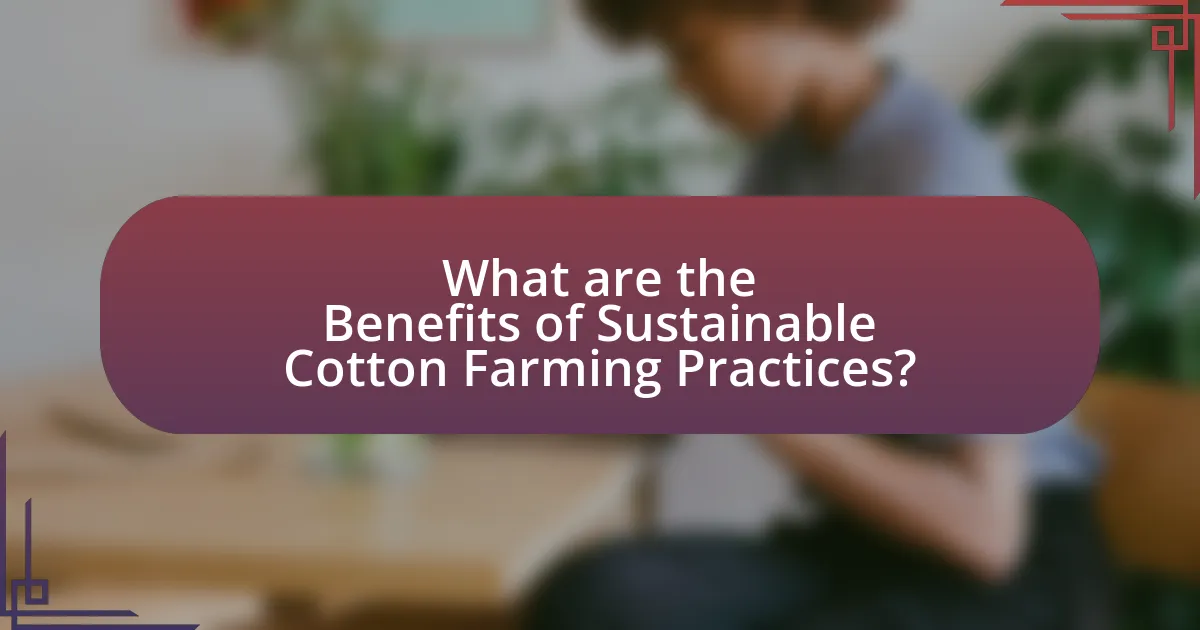
What are the Benefits of Sustainable Cotton Farming Practices?
Sustainable cotton farming practices provide numerous benefits, including reduced environmental impact, improved soil health, and enhanced economic viability for farmers. These practices minimize the use of harmful pesticides and fertilizers, leading to lower chemical runoff and better water quality. For instance, according to the World Wildlife Fund, sustainable cotton farming can reduce water usage by up to 90% compared to conventional methods. Additionally, these practices promote biodiversity by supporting various plant and animal species, which contributes to ecosystem resilience. Economically, farmers adopting sustainable methods often experience increased market access and premium prices for their cotton, as consumers increasingly demand ethically produced goods.
How does sustainable cotton farming impact farmers economically?
Sustainable cotton farming positively impacts farmers economically by reducing input costs and increasing profitability. By utilizing practices such as crop rotation, organic fertilizers, and integrated pest management, farmers can lower their reliance on expensive chemical inputs. Research indicates that sustainable practices can lead to a 20-30% reduction in production costs. Additionally, sustainable cotton often commands higher market prices due to increasing consumer demand for ethically produced goods, which can enhance farmers’ income. For instance, a study by the International Cotton Advisory Committee found that farmers adopting sustainable practices experienced a 10-15% increase in revenue compared to conventional farming methods.
What are the long-term financial benefits for farmers?
The long-term financial benefits for farmers practicing sustainable cotton farming include reduced input costs, increased crop yields, and enhanced market access. By adopting sustainable practices, farmers can lower expenses related to fertilizers and pesticides, as these methods often rely on natural alternatives. Research indicates that sustainable farming can lead to a 20-30% increase in yields over time due to improved soil health and biodiversity. Additionally, sustainable cotton is increasingly sought after in the market, allowing farmers to access premium prices and new consumer segments focused on ethical sourcing. These factors collectively contribute to a more stable and profitable farming operation in the long run.
How does sustainability affect market demand for cotton?
Sustainability significantly increases market demand for cotton as consumers increasingly prefer eco-friendly products. This shift is driven by growing awareness of environmental issues and a desire for sustainable practices in agriculture. According to a 2021 survey by McKinsey, 67% of consumers consider sustainability when making purchasing decisions, which directly influences their choice of cotton products. Furthermore, brands that adopt sustainable cotton sourcing report higher sales and customer loyalty, demonstrating that sustainable practices not only meet consumer expectations but also enhance market competitiveness.
What are the social benefits of sustainable cotton farming?
Sustainable cotton farming provides significant social benefits, including improved livelihoods for farmers and enhanced community health. By adopting sustainable practices, farmers often experience increased income due to higher market prices for organic cotton, which can lead to better living conditions and access to education for their families. Additionally, sustainable farming reduces the use of harmful pesticides, resulting in healthier communities and reduced health risks associated with chemical exposure. Research indicates that sustainable cotton farming can lead to a 30% increase in farmer income compared to conventional methods, thereby fostering economic stability within rural communities.
How does sustainable farming improve community health?
Sustainable farming improves community health by promoting the use of organic practices that reduce exposure to harmful chemicals and enhance food quality. By avoiding synthetic pesticides and fertilizers, sustainable farming minimizes the risk of chemical runoff into local water supplies, which can lead to health issues such as respiratory problems and developmental disorders. Additionally, sustainable practices often lead to increased biodiversity, which supports ecosystem health and resilience, further contributing to the well-being of communities. Research indicates that communities engaged in sustainable agriculture report better overall health outcomes, including lower rates of chronic diseases, due to improved nutrition from locally sourced, chemical-free produce.
What role does fair trade play in sustainable cotton practices?
Fair trade plays a crucial role in sustainable cotton practices by ensuring that farmers receive fair compensation, which promotes economic stability and encourages environmentally friendly farming methods. By adhering to fair trade standards, cotton producers are incentivized to adopt sustainable agricultural practices, such as organic farming and reduced pesticide use, which contribute to soil health and biodiversity. According to the Fair Trade Foundation, certified fair trade cotton farmers often report improved livelihoods and increased investment in sustainable practices, leading to a reduction in environmental impact and enhanced community resilience.
What challenges do farmers face in adopting sustainable practices?
Farmers face several challenges in adopting sustainable practices, including financial constraints, lack of knowledge, and limited access to resources. Financially, the initial investment for sustainable technologies and practices can be high, deterring farmers from making the switch. Additionally, many farmers may lack the necessary knowledge or training to implement these practices effectively, leading to uncertainty about their benefits. Limited access to resources, such as organic seeds or sustainable pest management options, further complicates the transition. According to a study published in the Journal of Sustainable Agriculture, 60% of farmers cited financial barriers as a significant obstacle to adopting sustainable practices, highlighting the need for targeted support and education in this area.
What are the economic barriers to transitioning to sustainable farming?
The economic barriers to transitioning to sustainable farming include high initial investment costs, limited access to financing, and market price volatility. High initial investment costs arise from the need for new equipment, technology, and practices that support sustainability, which can deter farmers from making the switch. Limited access to financing is a significant challenge, as many farmers may not qualify for loans or grants that could help cover these costs. Market price volatility further complicates the transition, as farmers may fear that the prices for sustainable products will not be stable or competitive compared to conventional farming products, leading to uncertainty in potential returns on investment. These barriers collectively hinder the widespread adoption of sustainable farming practices.
How can education and training help overcome these challenges?
Education and training can significantly help overcome challenges in sustainable cotton farming by equipping farmers with knowledge about best practices and innovative techniques. For instance, training programs can teach farmers about integrated pest management, which reduces pesticide use and promotes biodiversity. Research indicates that farmers who receive education on sustainable practices can increase their yields by up to 30% while minimizing environmental impact. Additionally, education fosters awareness of market demands for organic and sustainably produced cotton, enabling farmers to adapt their practices accordingly. This alignment with market trends can lead to better economic outcomes for farmers, as evidenced by a study from the International Cotton Advisory Committee, which found that sustainable practices can enhance profitability in the long term.
What practical steps can farmers take to implement sustainable practices?
Farmers can implement sustainable practices by adopting crop rotation, utilizing cover crops, and reducing chemical inputs. Crop rotation enhances soil health and reduces pest buildup, while cover crops prevent soil erosion and improve nutrient cycling. Additionally, integrating precision agriculture technologies allows farmers to optimize resource use, minimizing waste and environmental impact. Research indicates that these practices can lead to increased yields and reduced costs, supporting both economic viability and environmental sustainability in cotton farming.
